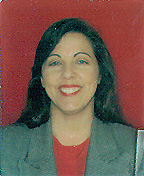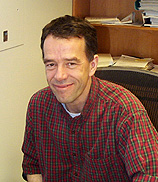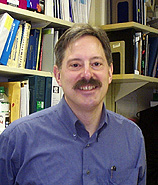
| T H E N I H C A T A L Y S T | M A R C H – A P R I L 2001 |
|
|
|
| P E O P L E |
RECENTLY
TENURED
 |
|
Joan
Bailey-Wilson
|
Joan Bailey-Wilson earned her Ph.D. in medical genetics with a minor in biomathematics from Indiana University in 1981. She then pursued postdoctoral training in statistical genetics with Robert C. Elston at the Louisiana State University Medical Center in New Orleans, where she joined the faculty in 1982 and rose to the rank of full professor in the Department of Biometry and Genetics before joining NIH in 1995. A diplomate of the American Board of Medical Genetics and founding fellow of the American College of Medical Genetics, she is currently a senior investigator and head of the Statistical Genetics Section in the NHGRI Inherited Disease Research Branch. She is also an adjunct full professor in the Department of Epidemiology at the Johns Hopkins University School of Public Health in Baltimore.
Over the course of my career, I have had a strong interest in the statistical genetic study of complex diseases, with an emphasis on human cancers—particularly lung, breast, colon, and prostate cancers. I have published segregation analyses predicting major susceptibility loci for breast cancer, HNPCC colon cancer, and lung cancer, as well as linkage studies implicating such loci for prostate and breast cancer.
My lung cancer analysis gave the first evidence for a Mendelian locus that may act in conjunction with smoking to influence lung cancer risk in some families. This was a major paradigm shift and stimulated other scientists in the field to do other segregation analyses that have shown similar results.
I am currently co-PI of a large collaborative linkage study of lung cancer and am PI of NIH studies of lung cancer and of oral clefts, as well as co-investigator on linkage studies of several other complex diseases, including prostate cancer, breast cancer, colon cancer, melanoma, myopia, inflammatory bowel disease, and familial intracranial aneurysm.
While applied research is of particular interest to me, I am also involved in various theoretical projects. The effect of misspecification of trait and marker models on the power and type I error rate of linkage statistics has been one of my strong theoretical interests for many years. My students and I have found that Haseman-Elston sib-pair linkage analysis is robust to misspecification of marker allele frequencies but that parametric lod-score linkage methods are not robust in the same situation—an important theoretical discovery.
We are currently pursuing the causes of this lack of robustness of parametric lod-score methods and devising methodological strategies to overcome it. We are also trying to determine which other popular statistical genetic analysis methods are not robust to misspecification of marker allele frequencies.
My interest in lung cancer genetics led me to a study of the effects of environmental covariates on the power of linkage. I have shown that existing methods of incorporating measured environmental exposures into Haseman-Elston sib-pair linkage are not powerful and have developed an analytic strategy that greatly improves power to detect a major locus when environmental exposures are important in the etiology of a complex disease.
This methodology is critical for adequate power to detect genes in complex traits, such as lung cancer, for which environmental exposures (such as cigarette smoke) are the most important causative factors.
Collaborative work on the search for susceptibility genes for prostate cancer, breast cancer, and melanoma have sparked an interest in extending current methods of family-based association analysis. These applied studies have produced evidence for linkage in various regions, and some of the data are particularly appropriate for linkage disequilibrium studies.
These studies are aimed at narrowing candidate regions for the locationof susceptibility genes. I have recently extended the Sibling-TDT methodology to allow analysis of an X-linked trait and have published these results in a joint paper with Gloria Ho, who extended the TDT in a similar manner.
I am also working with James Malley of NIH’s CIT to develop new likelihood-based bootstrap methods of association analysis that not only test for both linkage and association but are as powerful as or more powerful than the TDT and give estimates of both the association parameter and the linkage recombination fraction.
Traditionally, estimates of the recombination fraction have not been available from association data (either case-control or family-based). Thus, this new method represents a major advance in the field of family-based linkage disequilibrium mapping.
In the future, I intend to continue my focus on the development and testing of methods for the statistical genetic analysis of complex diseases. I also intend to continue my search for genetic loci that increase susceptibility to such complex disorders.
 |
|
Richard
Koup
|
Richard Koup received his M.D. from The Johns Hopkins University School of Medicine in Baltimore in 1982. He was a staff investigator at the Aaron Diamond AIDS Research Center in New York City before becoming chief of infectious diseases and professor of medicine and microbiology at the University of Texas Southwestern Medical Center, Dallas. He will be joining the Vaccine Research Center this summer as the director of the Human Immunology Program and chief of the Laboratory of Immunology.
I have been actively involved in HIV vaccine-related research for many years. My studies have focused on the role of HIV-specific cellular immunity in controlling HIV infection. I described the temporal association between the emergence of the cytotoxic T-lymphocyte (CTL) response to HIV and the initial control of viral replication in human infection, and I am the co-discoverer of a natural genetic mutation in the CCR5 co-receptor for HIV that provides significant protection against infection.
Most recently, my colleagues and I have shown that the adult thymus continues to produce naïve T cells and contributes to immune reconstitution in patients with treated HIV infection or patients who have undergone hematopoietic stem cell transplantation.
My lab’s long-term goal is to determine the influence of the cellular immune response on containment of HIV replication. The ultimate loss in immune control of HIV contributes greatly to disease progression, and a clear delineation of the processes leading to this loss of control will be crucial to the development of a protective, or at least effective, immune response to a vaccine.
The most practical way to achieve this in humans is to characterize—precisely and quantitatively—the correlations between fundamental aspects of the HIV-specific T-cell response and clinical and virologic parameters of HIV disease. This involves the analysis of the frequency, function, and specificity of HIV-specific T cells in response to HIV peptide antigens. We accomplish this primarily through intracellular cytokine analysis and a novel technique we developed that combines in vitro antigen stimulation and real-time quantitative clonotypic PCR.
HIV may evade cellular immune control through sequence variation within recognized epitopes. In addition, HIV may evade immune control by destroying CD4+ T cells needed to maintain the CTL response. To study this possibility, we are using newer methods that enable us to quantify the number, phenotype, and function of HIV-specific CD4+ and CD8+ T cells. These methods include a combination of intracellular cytokine staining, cytokine ELISA or Elispot, tetramer staining, and functional assays of cytotoxicity and T-cell division. With these tools, we can extensively characterize the T-cell response to HIV in patients in various stages of infection and thereby delineate which defects in immune response are leading to loss of control of HIV replication.
The classical role of a vaccine is to stimulate immunity that will protect against subsequent infection. In the case of HIV, there is another potential role for a vaccine: Because progressing HIV infection entails loss of immune control of the virus, a vaccine could be used to boost waning immunity and restore control of virus replication.
We plan to test the ability of therapeutic vaccination to alter virologic control in HIV-infected subjects by developing vaccines that boost specific cellular responses that are defective in HIV-infected subjects. To enable this and other vaccine research, we are also working to adapt assays of cellular immune function for high throughput screening and monitoring of clinical vaccine trials. I look forward to bringing this research to NIH this summer and sharing ideas and methods with investigators throughout the intramural research program.
 |
|
Roland
Martin
|
Roland Martin received his M.D. in 1982 from the University of Würzburg Medical School in Würzburg, Germany, where he then did postdoctoral work in the Department of Virology and Immunobiology and completed a residency in neurology. From 1989 to 1991, he was a postdoctoral fellow in the Neuroimmunology Branch, NINDS, and from 1991 to 1994 he worked as an assistant professor of neurology and clinical attending in the Department of Neurology at the University of Tübingen, Germany. From 1994 until 1996, as the recipient of a Heisenberg research professorship of the German Research Society, he supervised laboratories at the Neuroimmunology Branch, NINDS, and in Tübingen. He then spent a year in the neurology residency program at the University of Maryland at Baltimore and in 1998 joined the Neuroimmunology Branch, NINDS, as a tenure-track investigator. He is now acting chief of the Cellular Immunology Section.
From my time at medical school and later during fellowships in virology, immunology, and neuroimmunology, I have always had a strong interest in infectious and inflammatory diseases of the nervous system and in clinical neurology. Multiple sclerosis (MS) appeared the best field to apply and expand these interests. During the past 15 years, my work has focused on cellular immune function and antigen recognition in MS and also on nervous system manifestations of Lyme disease.
In Henry McFarland’s laboratory, we were among the first to show that T-cell reactivity against myelin components is observed not only in MS patients but essentially in every individual. This puzzling observation indicated that thymic negative selection is incomplete and that autoimmune T-cell responses may develop in every individual. Because this usually does not occur, much less lead to disease, scientists now assume that the appropriate immunogenetic background and an exogenous trigger, such as a viral infection, are probably required to induce pathogenic autoimmunity.
Using novel peptide chemistry approaches, we were able to demonstrate that T cells are capable of responding to a broad range of antigens—in some cases, with very high sensitivity. Combinatorial peptide libraries in the positional scanning format allowed us to identify systematically molecular mimics for autoreactive T-cell clones or for T cells from chronic infectious disorders such as Lyme disease.
An additional focus of our laboratory has been directed toward the development of novel immunomodulatory therapies for MS. A recent trial with an altered peptide ligand derived from an immunodominant peptide was disappointing from the therapeutic point of view because we were not able to show clinical benefit. However, we learned an important lesson from this trial. Some patients suffered exacerbations under peptide therapy, indicating that this myelin peptide is indeed an immune target in MS and that pathogenetic principles that have been deduced from animal experiments and human in vitro studies are valid.
Currently, the Cellular Immunology Section focuses on three major areas: the continuation of our studies of T-cell antigen recognition in autoimmune and inflammatory diseases, identification of disease-related genes and biomarkers in MS, and the development of novel treatment strategies for MS.
In our new approaches to MS treatment, we plan to combine immunomodulatory approaches with repair strategies such as stem-cell transfer. NIH offers an ideal collaborative environment to study basic mechanisms in human diseases in collaboration with other groups, translate this knowledge into new treatments, and eventually apply them in novel experimental trials.
 |
|
Jonathan
Vogel
|
The long-term goal of my laboratory is to understand how to introduce and successfully express genes in the skin in a manner that is therapeutically useful for clinical applications. For most purposes, this will require that the desired gene be expressed long enough in a significant percentage of keratinocytes.
Achieving persistent expression in a renewable tissue such as skin remains a challenge and will require stable gene insertion into keratinocyte stem cells. Our current laboratory efforts are focused on identifying and enriching keratinocyte stem cells, efficiently introducing genes into stem cells by genetic manipulations, and topically selecting in vivo for keratinocytes that express the transgene after they have been grafted onto a recipient.
In my earlier work at NIH, we developed a novel approach for directly introducing and transiently expressing genes in epidermis simply by injecting naked plasmid DNA into the dermis. In a series of studies, we characterized the uptake and expression of plasmid DNA in human, pig, and mouse skin. These studies showed that biological response modifiers, such as cytokine genes, could be expressed in the epidermis and achieve an expected biological effect, such as the recruitment of neutrophils.
Although skin gene expression with this direct approach was transient, we found it to be very effective for DNA vaccination. We next demonstrated that DNA vaccination with plasmids expressing Leishmania proteins can provide protection against Leishmania infection in susceptible mice due, in part, to the presence of immunostimulatory DNA sequences (nonmethylated CpG dinucleotides flanked by two 5’ purine nucleosides and two 3’ pyridine nucleosides) on the plasmid DNA.
Furthermore, oligodeoxynucleotides containing these immunostimulatory sequences were found to be effective adjuvants when combined with Leishmania protein antigens and were able to protect susceptible mice from infection. The adjuvant effect of these CpG-containing oligodeoxynucleotides could be explained by their activation of the dendritic antigen-presenting cells in the skin (such as Langerhans cells).
In the laboratory, skin organ cultures are an important tool for investigation. To help us understand the regulation of epidermal differentiation in these cultures, we have investigated how an epidermal-specific transcription factor, the POU family transcription factor Skn-1, regulates keratinocyte differentiation. In these studies, we characterized the transactivating and inhibitory domains of Skn-1 by mutational analysis. We demonstrated that Skn-1 enhances keratinocyte differentiation, the expression of differentiation-specific markers, and keratinocyte proliferation.
Although we have successfully introduced and transiently expressed genes in the skin in the studies described above, achieving long-term expression of desired genes in a significant percentage of keratinocytes has proved to be very difficult. Currently, it is not possible to introduce desired genes efficiently into keratinocyte stem cells. To address this issue, we are pursuing three complementary approaches.
First, we have developed
a model using topical treatments to select for keratinocyte stem cells that
contain and express a selectable marker gene linked to a gene of interest. Second,
we will evaluate whether different viral vectors, such as lentiviral vectors,
can introduce a desired gene into keratinocyte stem cells more efficiently than
the retroviral vectors traditionally used. Finally—and perhaps most importantly—we
are trying to identify unique keratinocyte stem cell surface markers (or patterns
of gene expression) so that the keratinocyte stem cells can be purified and
enriched for efficient genetic manipulation. ![]()